Experiments
1/42
Earn XP
Name | Mastery | Learn | Test | Matching | Spaced |
|---|
No study sessions yet.
43 Terms
Bem (2011)—retroactive facilitation of recall
reported a series of 9 experiments that claimed to provide evidence that “pre-cognition“ exists and that people unconsciously access the future to inform their past behaviors
experiments 8 and 9: participants studied a list of 48 words and then recalled them, then 24 of these words are randomly selected to be practiced. Bem found that participants remember more if the words were practiced again compared to the words that didn’t
Carney (2010)/Cuddy (2012)
power-poses (stand/sit in a way to make you look more powerful and confident) influence hormone levels and improve performance in interviews
failed to replicate
Dijksterhuis & Van Knippenberg (1998)
professor priming (exposure to one stimulus may influence a response to a subsequent stimulus unconsciously) make you better at a game of Trivial Pursuit
failed to replicate
Eric Kandel—Aplysia
Nobel prize winning work/creature in year 2000
studied sensitization and habituation in Aplysia
Aplysia learned to withdraw its gill pre-emptively before an electric shock was administered
Pavlov’s dog
initially started investigating digestion (production of saliva) and used dogs for his studies
by unconsciously connecting neutral stimuli with unconditioned response, production of saliva is automatic, which changes Pavlov’s research topic to how dogs predict the future
ex. associate bell (NS) with salivation (UCR) when at first, food (UCS) causes salivation (UCR)
present sound (NS) immediately before presentation of the food (UCS), so after a while, the food causes a reflex salivation process
before learning—innate reflex responses due to naturally rewarding/punishing
learning associations—forms predictive relationship between NS and UCR through acquisition trials
after conditioning—NS becomes CS while UCR becomes CR, so the salivation occur after the sound of the bell rang when food might not appear
Watson & Rayner—little albert study 1920
demonstrate classical conditioning in a human infant
first human fear-conditioning study
conditioned emotional responses in humans
Albert showed a natural startle response and distress to sudden loud noise of a metal bar being struck
condition Albert to fear a tame white rat that had not previously produced a fearful response
To associate, they have 2 instances in initial session, then 5 instances a week later
produce extreme fear response to the white rat alone (phobia)
generalization occurred to other furry animals, and Santa’s white beard
Burrhus Frederic Skinner—skinner box 1930
skinner box/operant chamber: microworld that can control the animal’s experience of reinforcement and punishment
pressing the lever is the target behavior
receive food pellet (positive reinforcement) to press the lever
terminate unpleasant stimulus, such as electric shock (negative reinforcement)
also allows visual or auditory stimuli (antecedent) to stimulate a response
Burrhus Frederic Skinner—Pigeons playing ping-pong
Shaping behavior through successive approximations
by reinforcing a high frequency component of the desired response
1. rewarded the pigeons when they were near the ball
2. rewarded them when they pecked the ball
3. rewarded them when they pecked the ball to the other side of the table
apply this reinforcement—behavior becomes more variable again
await a response that is still closer to the desired response, then reintroduce the reinforcer
keep cycling through closer approximations until the desired behavior are achieved
enables molding of a response that is not normally part of an animal’s life
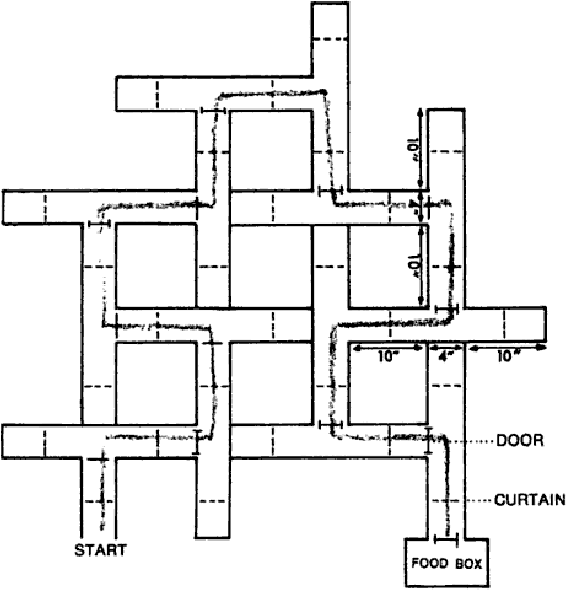
Tolman and Honzik (1930)—latent learning
3 groups of rats had to find their way around a complex maze. The experiment lasted 17 days. At the end of the maze, there was a food box. Group 1 got rewarded every time they reach the end. Group 2 got rewarded every time they reach the end during day 10-17. Group 3 doesn’t get rewarded
Group 2 shows that between stimulus (the maze) and response (reaching the end of the maze) a mediational process was occurring that allows the rats to actively process information in their brains by mentally using their cognitive map
in all groups, rats formed a cognitive map of the maze
rewards affect whether the learned behavior will be demonstrated, not whether learning has occurred
learning can occur in the absence of directly experienced rewards and punishments

Tolman 1948—Experiment II
first, rats learn and form a cognitive map of the maze on the left. then the rats were placed in the maze on the right. rats all started from going straight bc the cognitive map they form allows them to first go straight. but the maze on the right blocked the path for the middle, so rats started exploring where the food is. most rats choose lane 6 because it is approximately at the same position as the maze on the left, which they base their cognitive map on.
shows that rats formed a wider comprehensive map to the effect that food was located in such and such a direction in the room
Bandura (1965)
investigated the social and cognitive processes involved in how children learn to reproduced aggressive behaviors they have observed others perform
demonstrate that children will learn from what they observe, but will only perform that learning under certain conditions
3 groups of 4-yr-old children started watching a short film. after the film, the children were in a waiting room with lots of toys including any thing used by the model.
film began with the model walking up to an adult-size Bobo doll and exhibit 4 novel aggressive responses: 1) sat on it and punch the nose, 2) use a mallet to hit it on the head, 3) kicked it, 4) threw rubber balls at the doll
in model-rewarded condition, a second adult appeared with candies and soft drinks and inform the model that they did a great job. the admirer of the model did similar aggressive responses and received social reinforcement
in model-punished condition, someone came in scolding, so the model drew back, tripped and fell, and another adult sat on the model and spanked him with a roll-up magazine
in no consequences condition, children watch the film as it is without reinforcement/punishment ending
all children learned behaviors equally, but girls were less likely than boys to display the aggressive behaviors, regardless of incentives
demonstrate vicarious reinforcement and vicarious punishment, which shows that it is the expectation for reinforcement or punishment as a consequence of behavior that affected whether the children would demonstrate what they had learned through observation
knowledge remained latent in the model-punished condition until reward is introduced
George Sperling (1960)
determine capacity and duration of iconic memory
full-report versus partial report methods
full-report: using a computer, participants first see a central fixation cross that they have to focus on. then it is replaced by randomly selected array of 12 uppercase consonant letters, presented in 3 rows of 4 letters. the letter remains on screen for 50 msec. when the letters disappear, participants are required to say aloud as many of the letter names that they can remember from the array
-found that participants can only recall on average of 4 letters, but they reported a feeling that they briefly had access to the entire display, but it faded quickly
partial-report: array flashed for 50 msec, auditory tone indicates one line to be remembered
full report method underestimated the capacity of the iconic trace by confounding the reporting method with the duration of the iconic trace
estimated the duration by systematically varied the retention interval (recall time) between turning off the stimulus array and presenting the cue for which line to report
found that memory performance reduced to one item after approximately 500 msec
Jacobs 1887—digit-span task
participant hears a sequence of random digits, spoken at the rate of one digit per second. the task is to repeat back the sequence in the order it was presented as soon as the series has been spoken (immediate serial recall)
length of sequence is increased by one item after each successful attempt to determine the upper limit or span (ex. 749, 8521, etc. )
the participant’s span is reached when they fail on 2 trials at the given length
found an average of 7 digits recalled
Miller 1956
capacity of STM: “seven plus or minus two“ items of information
Brown-Peterson task (combination of John Brown (1958) and Lloyd and Margaret Peterson (1959)
participants hear 3 random letter spoken out loud then they are required to count backward in 3’s from a given number until told to stop. then they recall the 3 letters they heard.
measure the decay of STM by filling the retention interval with a task that prevents verbal rehearsal of the letter
after 3 sec interval, 50% of trials were likely to recall correctly. by 9 sec, only 20% were correct. between 12 to 18 sec, it has dropped to zero.
Craik and Tulving (1975)—levels of processing
test the idea that LTM for words is influenced by the depth level of the encoding process used in STM
participants saw a list of 20 words presented one at a time on a computer screen. before each word is presented, they heard one of 3 different kinds of questions that are designed to engage 3 different levels of processing (case, rhyme, sentence). answer questions by pushing the yes or no button-press. then participants were given another task to do for 5 mins, in which a surprise recognition memory test that consist of 180 words in a random order to each participant. (60 were in the question/answer task, 120 were other words similar in length and frequency and part of speech that weren’t in the task). this task was to indicate whether the word is old or new.
case (shallowest, only focus on visual)—”is this word written in upper case?”
rhyme (needs to mentally generate its sound)—”does this word rhyme with X” where X is a word that isn’t in the list
sentence (deepest, requires coding)—”could this word complete the sentence ‘the X ate the grass‘”
formed basis for the idea that “deeper“ encoding leads to richer connections with existing LTM, which increases likelihood to retrieve information
suggests that STM is a system that supports learning and reasoning rather than rehearsing information with primary goal for immediate recall
suggest a need for more detailed account of STM as a multi-component system that supports meaningful encoding and active reasoning and problem-solving
Working memory model—Alan Baddeley and Hitch (1986)
expands the concept of STM to a multi-component system governed by executive processes
active workspace for reasoning and problem-solving
abandon the concept of a unitary short-term store
emphasized the function of a system in problem-solving and complex cognition, rather than pure maintenance of memory
central executive is the attentional controller that directs attention to and retrieves information from phonological loop and visuospatial sketchpad for integration in the episodic buffer
phonological loop holds speech-based information
visuospatial sketchpad performs similar function for visual information
phonological loop and visuospatial sketchpad are independent, interacting sub-systems, one for visual and one for auditory. they access and update information in LTM
episodic buffer (added later) provides temporary storage system that binds together the inputs from the visual and auditory systems to represent the current contents of consciousness
-serves as a modelling space that is separate from LTM, but it is important when forming long-term episodic learning
-demonstrate the interactions between the visual and phonological STM buffers and LTM
Endel Tulving 1972
proposed that declarative memory can be sub-divided into the episodic and semantic memory systems
Henry Gustav Molaison (H. M.) (1926-2008)
Brenda Milner documented this case 1957 (4 yrs after surgery)
removal of medial portion of both temporal lobes, including hippocampi, to treat epilepsy
minor seizure at 9-10, major seizure from 16, near paralyzed at 27, so William Scoville offer the experimental surgery of removing the medial portion of both temporal lobes, including hippocampi. post-surgery he was described as severe anterograde amnesia (can’t consolidate or retrieve new episodic memory, severely impaired ability to learn new semantic facts) and temporally graded retrograde amnesia (memory worst for personally experienced events from years just before the operation)
unable to form new LTM since surgery or retain new semantic knowledge
indicate that medial temporal lobes are involved in formation of semantic and episodic long-term memories
surgery did control epileptic seizures and he still have normal sensory and working memory (STM)
inability to form, retain, and retrieve new declarative memories
unable to update his personal life because he can’t remember his daily experiences
can only properly remember experiences occurred before 16, which shows that episodic memory don’t permanently depend on the medial temporal lobe
suggests that there are interactions between hippocampus and relevant areas of the cerebral cortex
Mirror-tracing task—Corkin (1968), Milner (1962)
demonstrate that procedural learning can proceed independently of the brain systems required for declarative memories
H.M. could acquire new motor skills at a normal rate, and that his level of long-term retention of these new skills was comparable to that of healthy controls
given a picture of a star drawn with a double outline, H.M. need to draw a third outline of the star between the 2 already present, while looking only at the reflection of his hand and the star in a mirror. this task requires remapping of visual perception onto motor actions because of the mirror-reversed nature of the visual output.
although he can learn the skill, H.M. has no conscious recollection of ever having done it before, which shows a clear demonstration that declarative and non-declarative LTM can be distinguished in anterograde amnesia
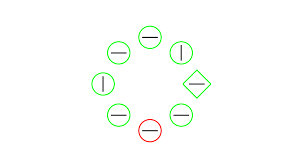
Theeuwes 1992—attentional capture
report orientation of the line in the green square
red circle was irrelevant, but because it was salient, attention was initially directed to it, and participants often reported the orientation of its line

Yarbus 1967
scan paths—the sequence of saccades and fixations during visual search
when researchers ask participants to determine age, remember clothing, remember positions of people and objects, participants pay attention to different parts of the scene
shows that voluntary attention is directed by goals

Vo & Henderson 2009
in experiment 1 participants viewed scenes in preparation for a subsequent memory task, while in experiment 2 participants were instructed to search for target objects
fixation on both semantically and syntactically inconsistent objects led to increased object processing as seen in elevated gaze durations and number of fixations
shows that fixation starts involuntary and later becomes voluntary, which are guided by expectations

Posner 1978
participants focus at the fixation point and given either valid cue (40%), invalid cue (10%), or no cue (50%) and they are suppose to determine where the X appears
when the valid cue was given, reaction time increases, which suggests that attention speeds responses to stimuli

Carrasco 2004
participants were required to report the direction of higher contrast grating
they compare grating at the stimuli page
when both grating were of equal contrast, participants usually report orientation of cued grating, which suggest that cued grating appeared to be higher contrast
shows that attention influence appearance because it made object appear to have a higher contrast
Anton-Erxleben (2007), Fuller & Carrasco (2006), Turatto (2007)
attention can make objects appear bigger, faster, and more richly colored
attention makes perception more vivid
attention affects not only how quickly a person can respond to a stimulus but also the appearance of the stimulus

Illusory conjunctions—Treisman & Schmidt, 1982
present character strings (ex. 9XTA5) very briefly (95-168ms) followed by noise mask
primary task was to report the 2 number, then participant’s were asked to report colored letters
results: participants often associate the wrong color with the wrong letter
incorrect binding is known as illusory conjunctions
The “door” study Daniel Simon and Daniel Levin (1998)—change blindness
50% of the participant didn’t notice when the person they were talking to was replaced by someone else
one of the first to demonstrate that change blindness can occur outside of the laboratory
random pedestrian been asked by experimenters to find directions. then 2 people carrying a door walks in between the pedestrian and the experimenter, and they change people asking direction with the help of the blockage of the door.
Athalye 2018
investigated what sort of images these state-of-the-art object recognition systems would misclassify
when given an image of a real life sea turtle in the ocean, the computer system classify it as an image of a rifle
misclassifications commonly occur with natural images if they are presented at unexpected orientations (Alcon, 2019)
common objects presented at unusual angles were often misclassified
shows that it is hard to build an effective image classifier
demonstrate that scene and object perception is quite difficult
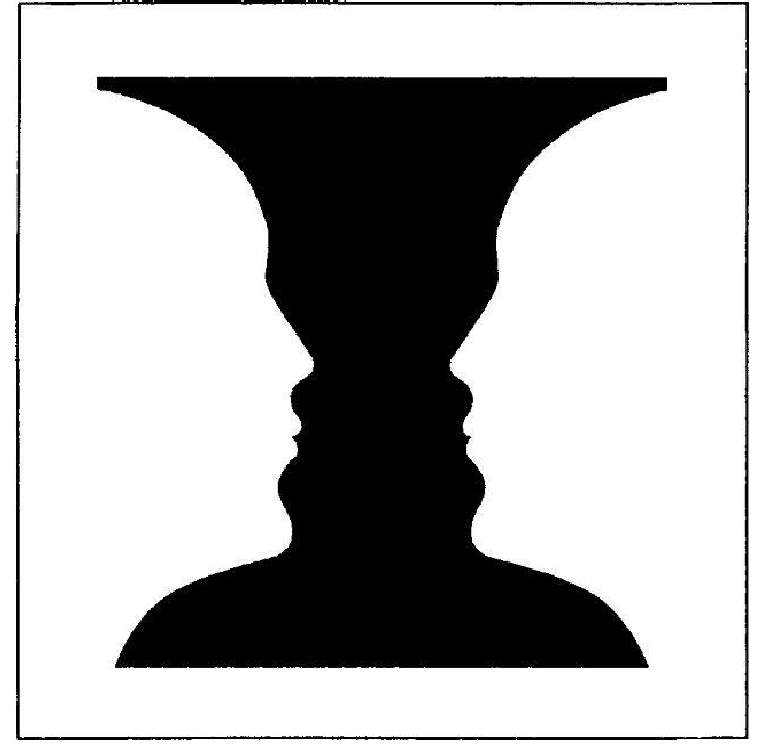
Rubin vase
perceive as either a vase or 2 face
not clear what the figure should be
depth ordering can affect figure perception, either the face is at the front or the vase

figure-ground assignment—Vecera 2002
Regions in the lower portion of a stimulus array appear more figure-like than regions in the upper portion of the display
demonstrated that the lower-region preference is not influenced by contrast, eye movements, or voluntary spatial attention
found that the lower region is defined relative to the stimulus display, linking the lower-region preference to pictorial depth perception cues
no left-right bias, so the image is ambiguous
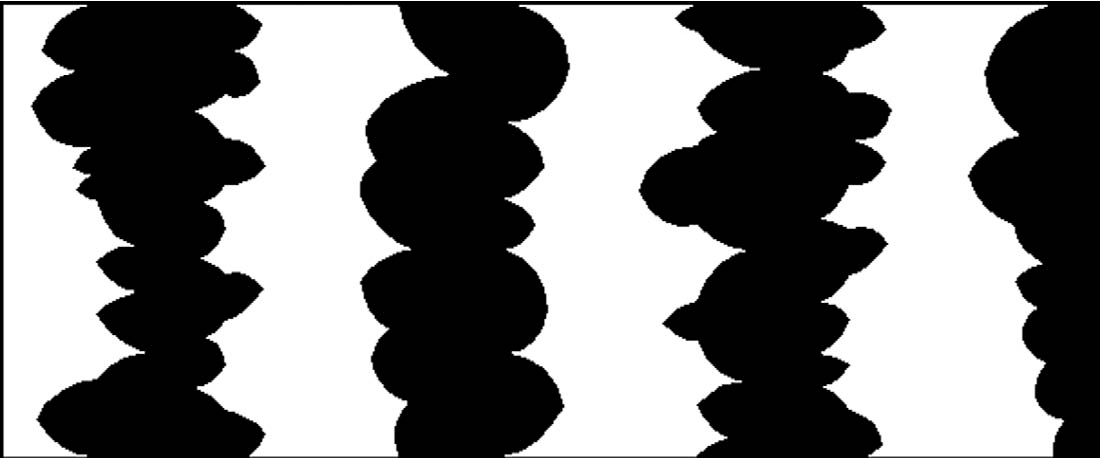
Figural properties—convexity (Peterson and Salvagio, 2008)
the bias toward seeing the convex side as figure increases as the number of edges delimiting alternating convex and concave regions increases
if you see a single border, there is a slight tendency to perceive the convex region as the figure
if you see multiple convex regions, with the same color, you are more likely to perceive those regions as figure
convex regions are assumed to be figures
Potter 1976—gist perception
in each trial, observer was cued with a particular scene description. then 16 randomly chosen scenes were shown, each for 250ms. then observer was asked if any of the scene fitted the description
near 100% accuracy, which shows that observers can rapidly perceive a scene’s gist
Li 2007—duration to form gist perception
investigated what the minimum scene exposure time is needed to perceive a scene’s gist
observers were presented with just a single scene, followed by a mask. then they were asked to describe what they had seen
no cues were given
seven possible times (27, 40, 53, 67, 80, 107, 500ms)
reported that the longer the stimulus presentation time, the more detailed and accurate the description
participants could start to perceive aspects of the scene at about 27ms, but not very detail
27ms→ mostly dark with some square things, maybe furniture
40ms→indoor shot, large frame object on white background
67ms→interior of a room in a house with black pictures to the right and table in the center. looks like dinning room
500ms→fancy 1800s living room with ornate single seaters and some portraits on the wall
L.M.
had akinetopsia
difficulties in pouring a cup of tea, crossing the street, following speech
can see that things had moved, but can’t see them moving
Motion aftereffect—Robert Adams (1834)
Robert Adams experienced waterfall illusion in Scotland
after staring at the waterfall for several minutes, he then shifted his gaze to the rock face which appeared to move upwards

Suchow & Alvarez (2011)—motion induced change blindness
when dots are stationary, it is very easy to notice them changing color
when they move, it is much more difficult to notice that they change color
normally color changes attract attention because of the transient/temporary signals associated with the change
when things are moving, there are transient signals associated with all objects, not just the one changing, so attention is no longer drawn preferentially to the changing objects, so the changes are not noticed

Anstis 2003—footsteps illusion
the two rectangles appear to move alternately, like a pair of stepping feet
as the rectangle traverse the stripped background, the contrast between the background and the rectangles vary
when the contrast is high, they appear to move faster and vice versa
because it is a stripped background, so the yellow and blue rectangles appear to speed up and slow down asynchronously
Goldstein & Brockmole (2016)
contribute to sensation and perception: depth & size perception and color perception
selective reflection of long wavelengths (opaque)
equal reflection of all wavelengths—appears white
selective transmission of long wavelengths (transparent)
mixing paint and mixing light experiments
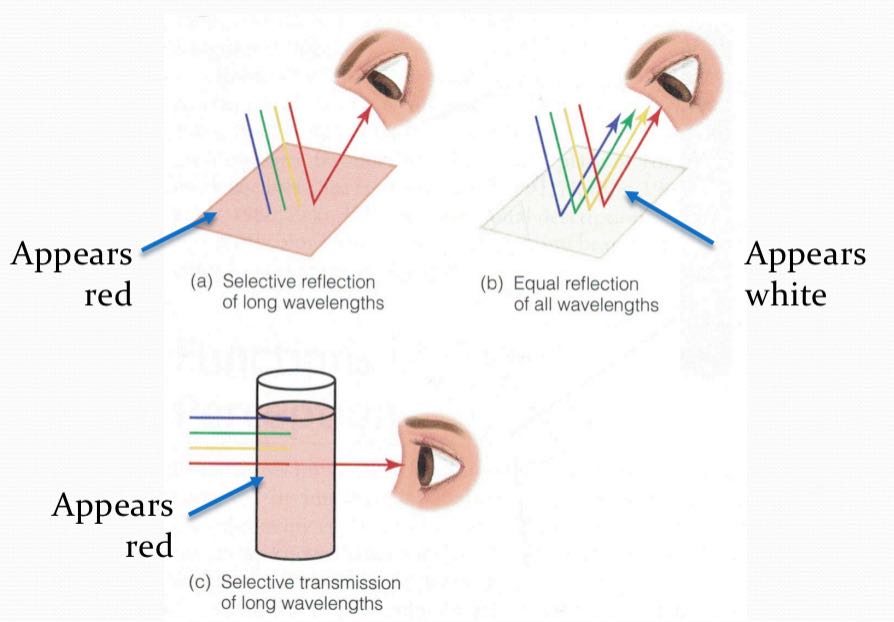
Holway and Boring (1941)
investigated how observers accurately estimate the size of objects
investigated how depth cues influence size judgements
observers sat at an intersection of 2 corridors and could view a test circle in one corridor and comparison circle in the other corridor
their task was to adjust the size of the comparison circle to match the size of the test circle
the test circles were of different sizes but were presented at different distances so that their angular size was always the same
condition 1, observers determine depth using binocular disparity, motion parallax, and shadows
condition 2, observers view test circle with 1 eye to remove binocular disparity
condition 3, observers view test circle through peephole to remove binocular disparity and motion parallax cues
condition 4, observers view circles through peephole and drapes/curtains to remove shadows
when there are sufficient depth cues, the size of the test patch can be accurately estimated, but when there are no sufficient depth cues, apparent size is biased towards visual angle, so further away test patches are perceived as smaller than they really are

Orientation selectivity—Hubel and Wiesel 1968
won Nobel prize in 1981
mapped development and functional organization of visual system
use a single light dot presented within the visual field of a house cat to map out the location of a cell's receptive field within the cat's visual field
found that some parts of the receptive fields had a region which are excitatory regions sandwiched between two inhibitory regions
inhibitory and excitatory regions together formed a single receptive field selective for stimulus shape fitting within the excitatory region
only a bar of light stimulus oriented at the correct angle and position within the receptive field covering only the excitatory region would express the greatest increase in the rate of impulse activity for that cell

Hodgkin & Huxley (1952)
recorded action potentials in giant axon of Atlantic squid
won Nobel prize in 1963
Seiji Ogawa 1990
blood vessels became more visible as blood oxygen decreased
basis for the blood-oxygen-level-dependent (BOLD) effect used for functional MRI
BOLD dominate fMRI studies that map human brain function
